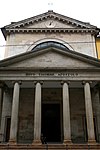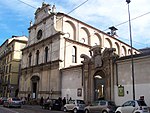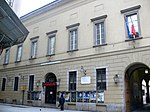Santa Maria alla Porta, Milan

Santa Maria alla Porta is a church in Milan, Italy. Although a church already stood in the same Milanese location since before the year 1105, the present church was erected in 1652 under Spanish rule. It was designed by architect Francesco Maria Richini, and after his death in 1658, the project was completed by Francesco Castelli—the original architect and engineer from Mendrisiotto (not to be confused with Francesco Castelli, colloquially known as "il Borromini") responsible for the construction of the Baroque gate and of the towering tympanum. The church owes its toponym "alla porta" [at the gate] to its construction where the old Porta Vercellina stood, as part of the wall erected in the Republican era by Augustus. The road facing the church, via Santa Maria alla Porta, was part of the decumanus (the east/west oriented road) that led from San Sepolcro Square to Porta Vercellina. It is a parish church in the Archdiocese of Milan which serves the Polish-Milanese community.
Excerpt from the Wikipedia article Santa Maria alla Porta, Milan (License: CC BY-SA 3.0, Authors, Images).Santa Maria alla Porta, Milan
Via Meravigli, Milan Municipio 1
Geographical coordinates (GPS) Address Nearby Places Show on map
Geographical coordinates (GPS)
| Latitude | Longitude |
|---|---|
| N 45.465555555556 ° | E 9.1813888888889 ° |
Address
Melluso
Via Meravigli 15
20123 Milan, Municipio 1
Lombardy, Italy
Open on Google Maps











